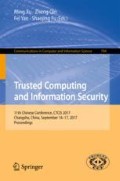Abstract
We study a general type of multiple-input multiple-output (G-MIMO) relay channels, which consist of two groups (A and B) of source nodes and one relay node. Both groups have arbitrarily many source nodes each of which is in turn equipped with an arbitrary number of antennas. A G-MIMO relay channel engages in two-way transmission of independent information via the relay node. We obtain a tight upper bound on the total degrees of freedom (DoF) for such G-MIMO relay channels. Under the reasonable assumption that the number of antennas at the relay node is no more than the total number of antennas of either Group A or Group B, we design an efficient transmission scheme to achieve the upper bound by using techniques of signal alignment and joint transceiver design for interference cancellation. At the end of the paper, we propose a future research topic to quantify the relationship between graded levels of network security and the corresponding DoF of the G-MIMO relay channels.
Access this chapter
Tax calculation will be finalised at checkout
Purchases are for personal use only
References
Zheng, L., Tse, D.N.: Packing spheres in the grassmann manifold: a geometric approach to the non-coherent multiantenna channel. IEEE Trans. Inform. Theory 48, February 2002
Jafar, S., Shamai, S.: Degrees of freedom region of the mimo x channel. IEEE Trans. Inform. Theory 54(1), 151–170 (2008)
Maddah-Ali, M., Motahari, A., Khandani, A.: Communication over mimo x channels: interference alignment, decomposition, and performance analysis. IEEE Trans. Inform. Theory 54(8), 3457–3470 (2008)
Cadambe, V., Jafar, S.: Interference alignment and degrees of freedom of the K-user interference channel. IEEE Trans. Inform. Theory 54(8), 3425–3441 (2008)
Zhou, X., Bai, B., Chen, W.: Invited paper: antenna selection in energy efficient MIMO systems: a survey. China Communications 12(9), 162–173 (2015)
Gou, T., Wang, C., Jafar, S.: Aiming perfectly in the dark-blind interference alignment through staggered antenna switching. IEEE Trans. Sig. Process. 59(6), 2734–2744 (2011)
Jafar, S.: The ergodic capacity of phase-fading interference networks. IEEE Trans. Inform. Theory 57(12), 7685–7694 (2011)
Gomadam, K., Cadambe, V., Jafar, S.: A distributed numerical approach to interference alignment and applications to wireless interference networks. IEEE Trans. Inform. Theory 57(6), 3309–3322 (2011)
Lee, N., Lim, J., Chun, J.: Degrees of freedom of the MIMO Y channel: signal space alignment for network coding. IEEE Trans. Inform. Theory 56(7), 3332–3342 (2010)
Lee, K., Lee, N., Lee, I.: Achievable degrees of freedom on k-user Y channels. IEEE Trans. Wireless Commun. 11(3), 1210–1219 (2012)
Wang, N., Ding, Z., Dai, X., Vasilakos, A.: On generalized MIMO Y channels: precoding design, mapping, and diversity gain. IEEE Trans. Veh. Technol. 60(7), 3525–3532 (2011)
Lee, K., Park, S., Kim, J., Lee, I.: Degrees of freedom on mimo multi-link two-way relay channels. In: Proceedings of the IEEE Globecom (2010)
Xiang, Z.Z., Tao, M.X., Mo, J.H., Wang, X.D.: Degrees of freedom for MIMO two-way X relay channel. IEEE Trans. Sig. Process. 61(7), 1711–1720 (2013)
Ahlswede, R., Cai, N., Li, S., Yeung, R.: Network information flow. IEEE Trans. Inform. Theory 46(4), 1204–1216 (2000)
Matsuda, T., Noguchi, T., Takine, T.: Survey of network coding and its applications. IEICE Trans. Commun. E94-B(3), 698–717 (2011)
Zhang, S., Liew, S., Lam, P.: Hot topic: physical-layer network coding. In: Proceedings of the ACM MobiCom, pp. 358–365, September 2006
Katti, S., Gollakota, S., Katabi, D.: Embracing wireless interference: analog network coding. In: Proceedings of the ACM SIGCOMM, September 2007
Zheng, L., Tse, D.: Diversity and multiplexing: a fundamental tradeoff in multiple-antenna channels. IEEE Trans. Inform. Theory 49(5), 1073–1096 (2003)
Cover, T., Gamal, A.: Capacity theorems for the relay channel. IEEE Trans. Inform. Theory 25(5), 572–584 (1979)
Acknowledgments
Xiao Chen and Liang Pang contributed equally to this work and share first authorship. This work was supported in part by the National Natural Science Foundation of China under Grant No. 61332010.
Author information
Authors and Affiliations
Corresponding author
Editor information
Editors and Affiliations
Rights and permissions
Copyright information
© 2017 Springer Nature Singapore Pte Ltd.
About this paper
Cite this paper
Chen, X., Pang, L., Guo, P., Sun, X., Xue, Z. (2017). New Upper Bounds on Degrees of Freedom for G-MIMO Relay Channel. In: Xu, M., Qin, Z., Yan, F., Fu, S. (eds) Trusted Computing and Information Security. CTCIS 2017. Communications in Computer and Information Science, vol 704. Springer, Singapore. https://doi.org/10.1007/978-981-10-7080-8_15
Download citation
DOI: https://doi.org/10.1007/978-981-10-7080-8_15
Published:
Publisher Name: Springer, Singapore
Print ISBN: 978-981-10-7079-2
Online ISBN: 978-981-10-7080-8
eBook Packages: Computer ScienceComputer Science (R0)


